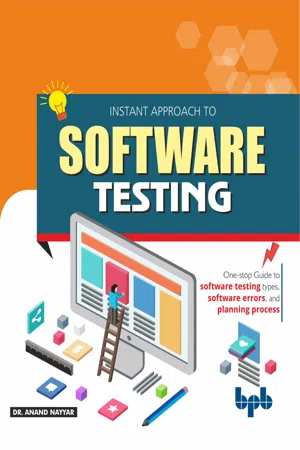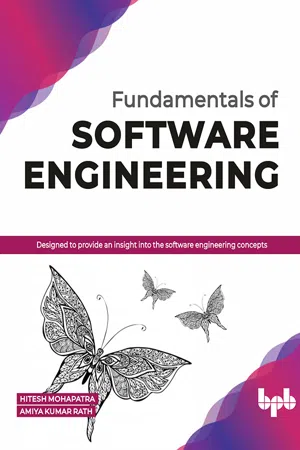Computer Science
Testing
Testing in computer science refers to the process of evaluating software or hardware to identify errors, bugs, or other issues. It involves running the program with various inputs to ensure that it behaves as expected and meets the specified requirements. Testing is crucial for ensuring the reliability, functionality, and performance of computer systems and applications.
Written by Perlego with AI-assistance
Related key terms
6 Key excerpts on "Testing"
- eBook - ePub
Instant Approach to Software Testing
Principles, Applications, Techniques, and Practices
- Dr Anand Nayyar(Author)
- 2020(Publication Date)
- BPB Publications(Publisher)
So, the main question is how the organizations develop these stable software systems and how the software systems are contributing effectively in businesses for attaining success by working correctly? The answer is Software Testing. Software Testing ensures that the software systems are efficient, without errors, scalable and as per the organizational requirements. So, nowadays, every small to large scale industries have separate and effective software Testing department to test software products before implementing and delivering at the client side.Software Testing is regarded as the most important component in Software Development Life Cycle (SDLC). It primarily performs the tasks of verifying the software under development to meet the requirements of Verification and Validation and delivering the software within the budget and time frame.Software Testing is termed as well-laid and defined procedure of detecting and correcting bugs in the software.Testing Definition’s & Overview
In 1979, Glenford Myers defined, “Testing is the process of executing a program or system with the intent of finding errors ” in his book titled “The Art of Software Testing ”.In 1983, Bill Hetzel defined “Testing is any activity aimed at evaluating an attribute of a program or systems. Testing the measurement of software quality ” in his book titled “Complete Guide to Software Testing ”.Other definitions of Testing are as follows:- Testing is a concurrent lifecycle process of engineering, using and maintaining testware in order to measure and improve the quality of the software being tested.
- As per IEEE 610 (Software Engineering Terminology): “The process of operating a system or component under specified conditions, observing or recording the results, and making an evaluation of some aspect of the system or component” .
- As per IEEE 829 (Test Documentation): “The process of analysing a software item to detect the difference between existing and required conditions (i.e. Bugs) and to evaluate the features of the software items”.
- eBook - ePub
Fundamentals of Software Engineering
Designed to provide an insight into the software engineering concepts
- Hitesh Mohapatra(Author)
- 2020(Publication Date)
- BPB Publications(Publisher)
C HAPTER 9 Software Testing Objective The objectives of Testing a system is to identify all defects existing in software, remove them, and achieve error-free operation under stated conditions for a stated period of time. Testing is vital to the success of a system. System Testing makes a logical assumption that if all the parts of the system are correct, the goal will be successfully achieved. Inadequate Testing or non-Testing leads to errors which may not appear until months later. This creates two problems : The time lag between the cause and the appearance of the problem (the longer the time interval, the more complicated the problem has become). The effect of the system errors on files and records within the system. Small system error can conceivably explode into a much larger problem. Effective Testing early in the process translates directly into long-term cost savings from a reduced number of errors. Another objective of system Testing is its utility as a user-oriented vehicle before implementation. The best program is worthless if it does not meet user needs. Unfortunately, the user’s demands are often compromised by the efforts to facilitate program or design efficiency in terms of processing time or memory utilization. Often the computer technician and the user have communication barriers due to different backgrounds, interests, priorities, and languages. The system tester (designer, programmer, or user) who has developed some computer mastery can bridge this barrier. In Software Development Life Cycle (SWDLC), Testing is the most important phase. The Testing is carried out along with system integration. All types of issues found are unresolved during requirement analysis, design, and coding stage - eBook - ePub
- Ron S. Kenett, Fabrizio Ruggeri, Frederick W. Faltin(Authors)
- 2018(Publication Date)
- Wiley(Publisher)
6 Conceptual Aspects in Development and Teaching of System and Software Test EngineeringDani Almog, Ron S. Kenett, Uri Shafrir, and Hadas ChasidimSynopsis
System and software Testing are important disciplines combining technical aspects with conceptual domains. While the reliability of systems and software is critical, many organizations involved in system and software development do not consider Testing as an engineering discipline. Moreover, most Testing team members do not have formal training, and university curricula, generally, do not prepare graduates with an understanding of test design and analysis methods. So, even though proper Testing has become more critical to software development because of the increased complexity of systems and software, not much innovation in Testing education or Testing design is being reported. This chapter presents a novel approach focused on improving the teaching of system and software Testing in academic and lifelong learning programs by introducing methodologies for conducting and assessing the process of education and training. The approach builds on meaning equivalence reusable learning objects (MERLO), which provide significant didactic advantages when one is interested in developing and assessing conceptual understanding of any knowledge domain. The scoring of MERLO items provides a statistical assessment of the level of conceptual understanding of students, and permits deep learning analysis of what is taught and how it is taught. Experience gained by teaching undergraduate and graduate students in a leading Israeli college, within a program dedicated to system and software Testing, is presented. Some implications for test engineering methods and system operational performance signatures are also discussed.6.1 Introduction
Software engineering, and especially software Testing and software quality as subdisciplines, are relatively new. In software engineering (SE) education, designed to prepare software engineers for industry, it is obvious that quality and Testing are important required software engineering skills. Software quality contains many elements, methods, and concepts that need to be integrated in an SE syllabus (Kenett and Baker, 2010 ; Ardis et al., 2015 - eBook - ePub
Software Testing
Concepts and Operations
- Ali Mili, Fairouz Tchier(Authors)
- 2015(Publication Date)
- Wiley(Publisher)
Like integration Testing, acceptance Testing is a system-wide test. But whereas integration Testing is focused on finding faults, acceptance Testing is focused on showing their absence, or at least highlighting their sparsity. This phase can also be used to carry out another form of Testing: Certification Testing, whose goal is to certify (or not) that the product meets some quality standard; this differs from acceptance Testing in that the goal is not to make a particular customer happy, but rather to satisfy a generic quality standard. Operations and Maintenance : If during the operation phase, the software product fails, or the software requirements change, then a maintenance operation is initiated to alter the software product accordingly. Upon the completion of the maintenance operation, the software system must be tested; but given that the maintenance operation may involve only a limited portion of the source code, or only limited aspects of system functionality, it may be advantageous to focus the Testing effort to those portions of the code that have been modified, or those functional aspects that are part of the altered requirements; this is called Regression Testing. Figure 3.1 illustrates this lifecycle, and highlights the Testing activities that take place therein. Each phase of this lifecycle concludes with a verification and validation step, intended to ensure that the deliverable that is produced in the phase is sufficiently trustworthy to serve as a launchpad for the next phase. Strictly speaking, validation ensures that the specification is valid (in the sense that it record all the valid requirements, and nothing but the valid requirements), whereas verification ensures that the product is correct with respect to the specification; hence, in theory, validation is used at the end of the requirements specification phase, and verification is used in all subsequent phases (see Fig. 3.2 for a summary illustration) - eBook - ePub
- Ashfaque Ahmed, Bhanu Prasad(Authors)
- 2016(Publication Date)
- Auerbach Publications(Publisher)
In fact, alpha and beta Testing are the most cost-effective way for any vendor to get its products tested thoroughly within a short time span by thousands of end users. The vendor saves time and Testing costs by having the end users themselves test the product for free.9.12 Test Case DesignA test case is a statement that defines what needs to be tested, how it will be tested, what is the precondition for that Testing, and what is the expected output from that Testing. Before you can write a test case, you need to think about how you should design your test cases to make your Testing effective.Software Testing is all about verifying if a software product is working as per the requirement and design specifications of that product. This is done by taking each requirement or design specification and making a test case based on it. The test case consists of providing some input to the software product, having an expected outcome when the software product is run, and then finding the actual outcome. Comparing the expected and actual outcomes will provide information on whether the particular test case has passed or failed. If the test case has passed, then it means that the software product feature is running fine for what has been tested. If the test case fails, then the software product feature is not running as expected.A test case may consist of many fields such as the serial number of the test case, test statement (i.e., test case description), entry criteria, exit criteria, expected result, actual result, tested by, test date, and supporting facts. Table 9.1 shows a test case template. This kind of template can be used to create the test cases.A serial number for a test case can be any number that will clearly identify the test case for managing the Testing activities related to that test case. The test statement defines what operations will be carried out during that test, for example, clicking on the Submit button on the main web page of the software product that is being tested. The entry criteria for a test are the requirements that need to be fulfilled before the test can run. For example, if the main web page has a textbox to fill out, then part of the entry criteria is filling out that textbox before clicking the Submit button. The exit criteria for a test case are a set of conditions based on which you can determine that the test case execution is finished. For example, after clicking the Submit button on the web page, if the web page navigates to the results page, then this is the exit criteria. - eBook - ePub
Software Testing
An ISEB Intermediate Certificate
- Brian Hambling, Angelina Samaroo(Authors)
- 2009(Publication Date)
- British Computer Society(Publisher)
Other areas that support the project, such as technical support and technical writing, will also need an interface with Testing. Manuals will need to be included in Testing at some stage in the project to ensure that Testing correctly reflects the user procedures described in them. Technical support may be involved in building or supporting test environments and software builds for Testing.In an iterative life cycle the processes may not be so distinct. The team members may take on different roles at different times, blurring the distinctions between roles such as project manager, configuration manager and tester.Testing, MAINTENANCE AND CHANGE Testing and change Testing, if it is effective, will find defects and thus generate change to the software and the requirements. In a sequential life cycle, in which tight control is maintained over work products at every stage, we will need to recognise four distinct activities:CHECK OF UNDERSTANDING CU4 List three other project processes that interact with the Testing process.- Debugging, though not strictly Testing at all, will be the first level of defect removal. Debugging will normally be done by the development team and typically will not be documented; neither will the debugged code be under project version control at this stage (though the development team should be providing local version control). Debugging is preparation for Testing, seeking to bring software to a state where formal Testing can begin.
- Initial Testing is the execution of the tests specified in the appropriate test specification and is part of every test level. The initial tests will typically uncover a number of defects.
Learn about this page
Index pages curate the most relevant extracts from our library of academic textbooks. They’ve been created using an in-house natural language model (NLM), each adding context and meaning to key research topics.





